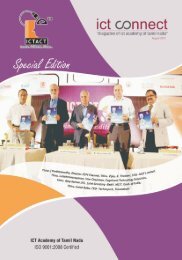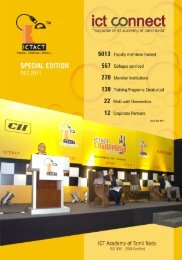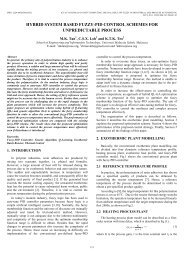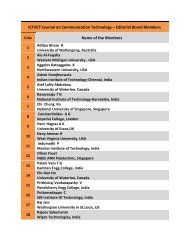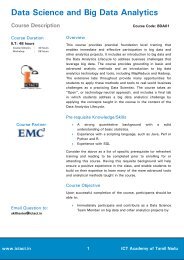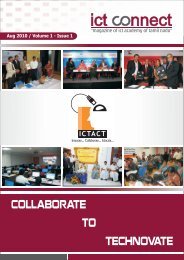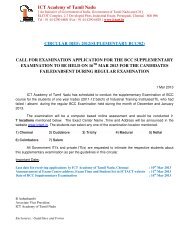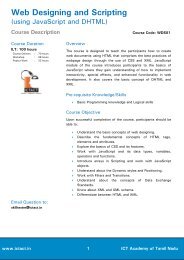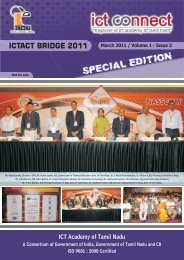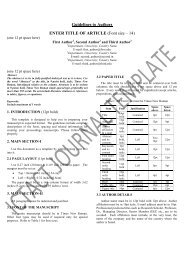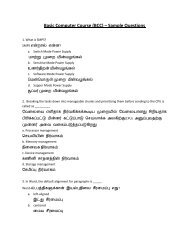Volume 1 - Issue 8 - ICTACT.IN
Volume 1 - Issue 8 - ICTACT.IN
Volume 1 - Issue 8 - ICTACT.IN
Create successful ePaper yourself
Turn your PDF publications into a flip-book with our unique Google optimized e-Paper software.
Cover StorySession 1: Impact of Technologies on Institutions,Teachers & StudentsThe illiterate of the 21st century arenot who cannot read and write , butare who cannot learn ,unlearn andrelearn.Mr. Chandrasekhar ChenniappanHead Of Human Resources – India,Atmel CorporationThis session was moderated byChandrasekaran Chenniapan. He introducedthe panel members. He started witha quote “the illiterate of the 21st centuryare not who cannot read and write , but arewho cannot learn ,unlearn and relearn”With all the technology advancementthe teachers have to reinvent theirway of teaching. They should movefrom teaching to mentoring.Mr. Praveen Parameswaran,Offshore Head of Sourcing,UST GlobalMr.Praveen Parameshwaran invitedthe audience and said that he will nevermiss any opportunity to interact with theacademicians. He started with a question“How do I learn ,Unlearn and relearn”.He mentioned about the technologychanges that is taking place and thesetechnology will evolve as the people wants.He briefed about certain factors that haschanged.1. Myth about enclosed classroomsession2. Impact of cloud computing - accessdata where they want3. Collaboration for cause - Nomore restricted by distance, availabilityand power of knowledgeNow-a-days the students are muchmore equipped to source more informationthan the teacher. Hybrid learning modulesare prevalent now to collect informationtoday. All these are possible with thehelp of advancement in the social media.Thus the classroom from being Lecturercentricis now student-centric. WithGoogle, information is available all over. Allthe new models of education are creatingchallenges to the old techniques. There areonline mechanisms to guide the studentsthrough the curriculum. The new form ofpublishing has also changed. There aremore number of white papers developednowadays.With all these developments the studentcommunity has undergone, but theteachers are not exposed to any of them.This has created a huge gap between theteachers and the students. With all thesetechnology developments the library arealso becoming a challenge. The StanfordUniversity develops and delivers contenton I-tune. With these examples we haveto use these applications to enable learning.That is where the learning communityis moving, without which the educationsector will become redundant.Mr.Vijay Anand started with a thankingnote to ICT Academy for giving him theopportunity to address the think tank of thestate. He said he will talk about how technologycan enable education and learning.He asked the audience about their knowledgeof machine to machine. He continuedabout intelligent devices and the deliveryof business value. He said M to M wasthere for ages, but then it was not widelyused. With the cost of technology andcommunication becoming cheaper, M to Mis more prevalent now-a-days.Every house hold has at least 10 devicesthat can connect with each otherand deliver business value for the people.He asked whether the academicians areequipped to address this massive kind ofgrowth in the technology. He mentionedabout the offshore delivery centres andstated that we need to move beyond that.The students have to move to the levelof inventing different things than maintainingvarious technologies developed by thewestern countries.Mr.Vinoth Chelambathodi started thesession on giving back to the society, thusbenefitting the society. But if you give backto the institutions the benefits multiplyseveral times. He started the session witha series of questions.The students have to moveto the level of inventingdifferent things than maintainingvarious technologyMr. Vijay Anand V RChief Technology OfficerCGI IndiaJune 2013 I 8



